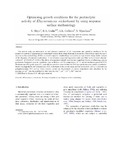| dc.contributor.author | Moyo, S. | |
| dc.contributor.author | Gashe, B.A. | |
| dc.contributor.author | Collison, E.K. | |
| dc.contributor.author | Mpuchane, S. | |
| dc.date.accessioned | 2008-10-09T09:23:14Z | |
| dc.date.available | 2008-10-09T09:23:14Z | |
| dc.date.issued | 2003 | |
| dc.identifier.citation | Moyo, S. et al (2003) Optimising growth conditions for the pectinolytic activity of Kluyveromyces wickerhamii by using response surface methodology, International Journal of Food Microbiology, Vol. 85, pp. 87-100 | en |
| dc.identifier.issn | 0168-1605 | |
| dc.identifier.uri | http://hdl.handle.net/10311/228 | |
| dc.description.abstract | This present study was undertaken to find optimum conditions of pH, temperature and, period of incubation for the
pectinolytic activity of Kluyveromyces wickerhamii isolated from rotting fruits and to assess the effect of these factors by use of
response surface methodology (RSM). A central composite rotatable design was used as an experimental design for the analysis
of the allocation of treatment combinations. A second order polynomial regression model was fitted and was found adequate,
with an R2 of 0.94469 ( P < 0.001). The effects of temperature and pH were the most significant factors in influencing enzyme
production. Estimated optimum conditions were as follows: pH 5.0, temperature, 32 jC and an incubation period of 91 h.
Pectinesterase (PE), pectin lyase (PL), and cellulase activities were not detected. Pectinase production was partially constitutive.
Pectin was degraded by the isolated strain of K. wickerhamii in the current study, and the pectinolytic activity is referred to as
polygalacturonase (PG) activity. Crude enzyme extract was thermostable at various temperatures and, stimulated by the
presence of Ca2 + ions but inhibited by other ions like Mg2 +, Zn2 +, Co2 +, Mn2 + and Na+. | en |
| dc.language.iso | en | en |
| dc.publisher | Elsevier / www.elsevier.com/locate/ijfoodmicro | en |
| dc.subject | Kluyveromyces wickerhamii | en |
| dc.subject | Pectinase | en |
| dc.subject | Polygalacturonase | en |
| dc.subject | Response surface methodology | en |
| dc.title | Optimising growth conditions for the pectinolytic activity of Kluyveromyces wickerhamii by using response surface methodology | en |
| dc.type | Article | en |

